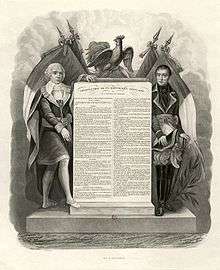French Constitution of 1795

Constitution de la République Française du 5 Fructidor l'an III (22 août 1795)
 |
French Wikisource has original text related to this article:
|
The Constitution of 22 August 1795 (also known as the Constitution of the Year III, or the Constitution of 5 Fructidor) was a national constitution of France ratified by the National Convention on 22 August 1795 (5 Fructidor of the Year III under the French Revolutionary Calendar) during the French Revolution. It established the Directory, and remained in effect until the coup of 18 Brumaire (9 November 1799) effectively ended the Revolution and began the ascendancy of Napoleon Bonaparte. It was more conservative than the abortive democratic French Constitution of 1793. The Constitution of 1795 established a liberal republic with a franchise based on the payment of taxes, similar to that of the French Constitution of 1791; a bicameral legislature, (Council of Ancients, and a Council of 500) to slow down the legislative process; and a five-man Directory. The central government retained great power, including emergency powers to curb freedom of the press and freedom of association. The Declaration of Rights and Duties of Mankind at the beginning of the constitution included an explicit ban on slavery. It was succeeded by the Constitution of the Year VIII, which established the Consulate.
|
|---|
| | | | Significant civil and political events by year |
|---|
| | 1788 | |
|---|
| | 1789 | |
|---|
| | 1790 | |
|---|
| | 1791 | |
|---|
| | 1792 | |
|---|
| | 1793 | |
|---|
| | 1794 | |
|---|
| | 1795 | |
|---|
| | 1797 | |
|---|
| | 1799 | |
|---|
| | | | | Military leaders |
|---|
|  French Army French Army | |
|---|
|  French Navy French Navy | |
|---|
| | Opposition | |
|---|
| | | | | | |
|
